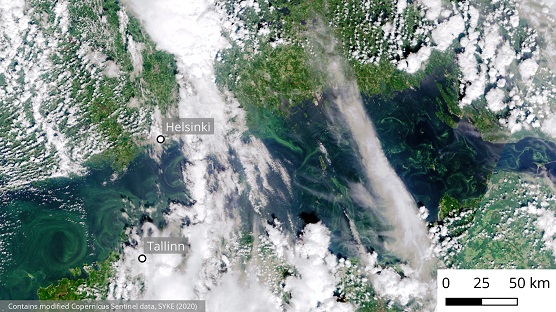Press release 2020-07-23 at 13:55

Satellite observation from the Gulf of Finland from Tuesday 21st of July. Cyanobacteria have been observed mixed in the water column or as surface accumulations all the way from the opening of the Gulf of Finland to the front of the river Neva. Cloudiness complicates cyanobacterial observations in the central Gulf of Finland. Contains modified Copernicus data, SYKE (2020). See more at the
TARKKA web map application.
Cyanobacteria have been observed in both sea areas and lakes. In the sea areas, cyanobacteria are mostly mixed in the water due to strong winds. In the coastal areas, cyanobacteria have been observed mostly in the Gulf of Finland, the Archipelago Sea and the Bothnian Sea. In lakes, amounts of cyanobacteria have been slightly increasing since last week due to warm weather during last weekend. Cyanobacterial situation is typical for this time of summer; cyanobacteria are most abundant usually in the end of July and in the beginning of August.
Read more in Finnish
Report your algal bloom observations to the Järvi-meriwiki (Lake and sea wiki)
In the Järvi-meriwiki maintained by the Finnish Environment Institute, everyone has the opportunity to establish their own observation site and share algal bloom observations from lakes and coastal areas. Individual observations can also be sent while navigating different water bodies. You can also report observations using the smartphone-friendly Havaintolähetti website. The reported observations are shown on the national algal situation map, and they support the national algal situation assessment. Observations about the absence of cyanobacteria are also important.
Järvi-meriwiki is an online service produced in collaboration with authorities and citizens. The service provides basic information on all lakes larger than one hectare as well as different areas of the Baltic Sea. Users can share, for example, photos and other observations on the service.
Municipalities and cities monitor the cyanobacterial situation on the beaches, so it is advisable to report rich cyanobacterial blooms on beaches to the health authorities of the municipality in question.
Cyanobacteria observations also in the Itämeri.fi service
This summer, a website on algal bloom observations on the Itämeri.fi service is also launched. The cyanobacterial map presented on this algal bloom observations page combines the observations reported to the Järvi-meriwiki and from the beaches of the City of Helsinki as well as the observations based on satellite interpretations of the Finnish Environment Institute during the last three days.
This is how you identify cyanobacteria
A small amount of cyanobacteria in the water appears as green or yellowish particles. Narrow stripes of algae can drift to a beach. In calm weather, a substantial amount of cyanobacteria forms greenish or yellowish algal rafts and piles up in coastal water. Unlike cyanobacteria, pollen is found not only on the surface water but also, for example, on piers or yard furniture.
If the algae dissolve into tiny particles in the water when you touch it with a stick, it may be cyanobacteria. If the algae attache to the stick, it is something other than cyanobacteria. In a glass of water, cyanobacteria rise to the surface as tiny greenish particles within about an hour.
Algae bloom risk analysis
The risk of cyanobacterial blooms in the Finnish sea areas is considerable or moderate – the summer weather determines the actual situation (Press release June 4, 2020)
Information about algae situation
Satellite images
Give your opinion on improving the status of waterways
More information
(Telephone 1.00 - 3.00 pm)
Lakes
- University Intern Jere Laine, Suomen ympäristökeskus SYKE, Tel. +358 295 252 205, firstname.lastname@ymparisto.fi
Sea areas
Cyanobacterial bloom situation
- Senior Research Scientist Sirpa Lehtinen, Finnish Environment Institute SYKE, Tel. +358 295 251 353, firstname.lastname@ymparisto.fi
State of the Baltic Sea
- Senior Researcher Antti Räike, Finnish Environment Institute SYKE, Tel. +358 295 251 586, firstname.lastname@ymparisto.fi
Satellite observations
-
Researcher Sakari Väkevä, Finnish Environment Institute SYKE, Tel. +358 29 525 2088, firstname.lastname@ymparisto.fi
Communications
- Communications Intern Iris Aarola, Finnish Environment Institute SYKE, Tel +358 295 252 189, firstname.lastname@ymparisto.fi